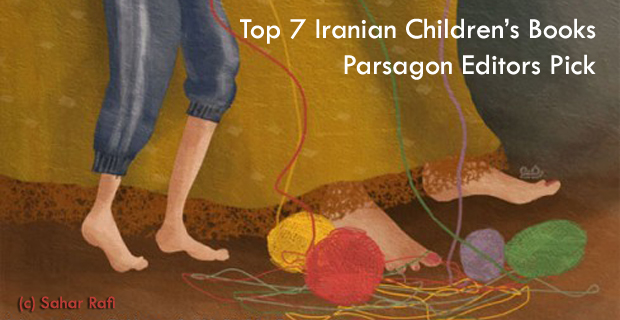
Since 1967, International Children’s Book Day (ICBD) is celebrated on April 2, on or around Hans Christian Andersen’s birthday, to inspire the love of reading and to call attention to children’s books. That’s a good reason for the Parsagon Editors to share the top seven of their favorite childhood picks and probably some of Iran’s most popular contemporary children’s books with you.
I. The Little Black Fish (1968) by Samad Behrangi (1939-1967) is the story of an adventurous little black fish which sets out on a quest to explore the stream where it lives. The story is translated to many languages including English, Turkish, and Pashtoo. It was also awarded the Golden Plaque of Bologna in 1969 and the Honorary Diploma of BIB in the same year. The Little Black Fish is a very popular children’s story and is best remembered by many generations. The complete book is available at Shahrefarang.
II. Olduz and Her Doll (1967) another popular story by Samad Behrangi follows one of the grand narratives of Iranian oral literature as well as world literature, the lonely girl and her unkind stepmother. Olduz’ father gets divorced and marries a cruel woman. Olduz is left alone and unloved. But she has a lovely cow and a doll to play with. After the stepmother decides to kill the cow, Olduz is even lonelier and decides to talk with her doll. The doll suddenly begins to speak and takes Olduz, her father and Yashar, the neighbor boy, to a better place in the jungle. The stepmother gets suspicious and… This volume is followed by a second one titled Olduz and the Crows. They are often published together.
III. The Rainbow (1979) An illustrated book with songs for children by Samin Baghcheban. The songs in this collection – now part of everyone’s childhood memories – were recoded by members of Radio Vienna’s Symphonic Orchestra, composed by Samin himself and illustrated by Parviz Kalantari.
Learn more about the collection here.
IV. The Hedgehog, My Doll and I (1979) is a shockingly bitter story about poverty and its degrading effects on social and personal lives of men, women and children, written by Razieh Dehqan Salmasi in the feverish days of public cry against social injustice and revolution. It is illustrated by the master of children’s book illustration, Farshid Mesghali. You can read the complete text of the story here.
V. Good Stories for Good Children (1965) The hard task of rewriting old tales and oral literature for contemporary children was undertaken by Mahdi Azar-Yazdi in five volumes, the first of which retold the stories of Kalila and Dimna in simple modern prose. The series won the Annual Imperial Book Awards and a UNESCO Prize a decade before the revolution and is still being reprinted and widely read for children. The Persian audio version of a number of these stories are available online here.
VI. The Stories of Majid (1985), Written by Houshang Moradi Kermani, the series soon became a bestseller and the winner of the 1985 Book of the Year Award. A popular character, Majid is a little boy who lives with his grandmother in the city of Kerman (in the movie version they live in Isfahan). Written in the sincere tone of a naughty yet thoughtful teenager and packed with humor and laughter, Majid Stories became so popular that the renowned filmmaker, Kiumars Pourahmad, made a very successful TV series based on them. The series was broadcasted in Iran and attracted wide attention during the 1990s.
VII. Elephant in the Dark House (2006) In this prizewinning volume, Firoozeh Golmohammadi had masterfully rewritten and illustrated ten famous couplets by Jalaleddin Mawlavi Rumi and the well-known parable of the elephant in the dark. The parable, a peerless allegory of the limitations of human knowledge, portrays how the people who cannot see the animal in the dark have totally different ideas of what they have found. Although published as a children’s book, it can be enjoyed by different age groups.

In book Majid lives in kerman not in isfahan. In the serie he lives in isfahan due to lack of movie making facilities in kerman on that time..